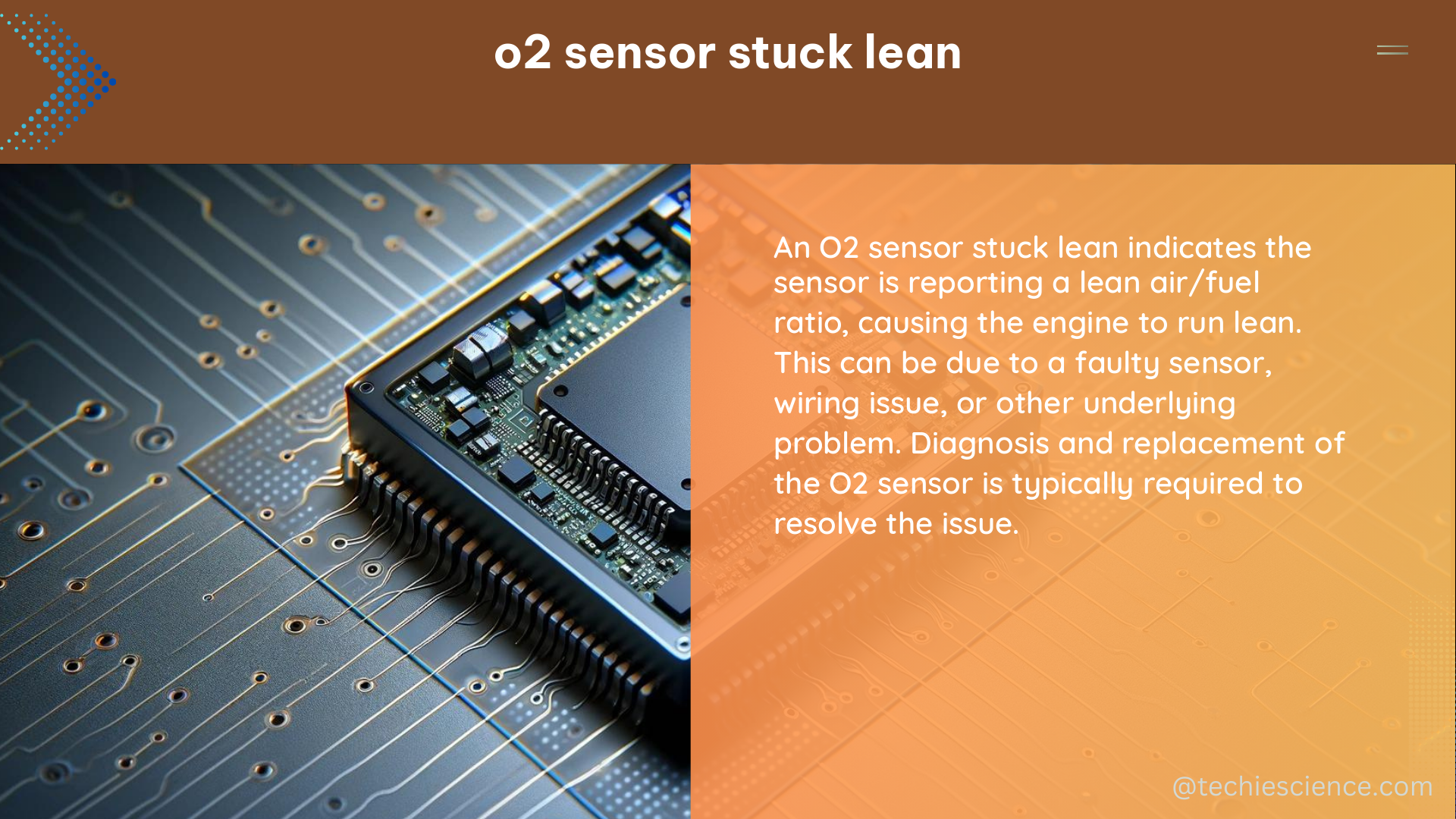An O2 (oxygen) sensor, also known as a lambda sensor, is a critical component in a vehicle’s engine management system. It measures the oxygen content in the exhaust, allowing the engine control unit (ECU) to adjust the air-fuel ratio for optimal combustion and emissions. When an O2 sensor becomes stuck in a lean condition, it can lead to a range of performance and efficiency issues. This comprehensive guide will provide you with the necessary information to diagnose and repair an O2 sensor stuck lean.
Understanding O2 Sensor Operation
The O2 sensor is responsible for monitoring the air-fuel ratio in the exhaust system. It generates a voltage signal that fluctuates between 0.1 volts (lean) and 0.9 volts (rich) as the air-fuel ratio changes. The ECU uses this information to adjust the fuel injection and ignition timing to maintain the optimal air-fuel ratio for efficient combustion and reduced emissions.
When the air-fuel ratio is too lean (too much air, not enough fuel), the O2 sensor will read a higher oxygen content in the exhaust, resulting in a consistently high voltage output. This condition is known as an “O2 sensor stuck lean.”
Diagnosing an O2 Sensor Stuck Lean

To diagnose an O2 sensor stuck lean, you can use a variety of tools and techniques:
Scan Tool Monitoring
- Connect a diagnostic scan tool to the vehicle’s OBD-II port.
- Monitor the O2 sensor voltage output. A healthy sensor should fluctuate between 0.1 and 0.9 volts.
- If the voltage remains consistently high (above 0.6 volts), it may indicate an O2 sensor stuck lean.
Exhaust Gas Analysis
- Use a professional-grade exhaust gas analyzer to measure the oxygen content in the vehicle’s exhaust.
- A healthy engine should have an oxygen level between 1-3%.
- If the oxygen level is consistently above 3%, it may indicate an O2 sensor stuck lean.
Multimeter Resistance Check
- Use a digital multimeter to measure the resistance of the O2 sensor.
- The resistance should typically be between 1-5 ohms for most O2 sensors.
- If the resistance is outside of this range, it may indicate a faulty O2 sensor.
Smoke Machine Inspection
- Use a smoke machine to check for vacuum leaks or other issues that could be causing a lean air-fuel mixture.
- Inspect the entire intake and exhaust system for any signs of leaks or damage.
- Repair any identified issues, as they can contribute to an O2 sensor stuck lean condition.
Repairing an O2 Sensor Stuck Lean
If the diagnosis confirms an O2 sensor stuck lean, there are a few steps you can take to repair the issue:
-
O2 Sensor Cleaning: Try cleaning the O2 sensor with a specialized cleaning solution. This can sometimes remove deposits or contaminants that are causing the sensor to read lean.
-
O2 Sensor Replacement: If cleaning the sensor does not resolve the issue, you may need to replace the O2 sensor with a new one. Ensure that the replacement sensor is compatible with your vehicle’s make, model, and year.
-
Engine Control System Inspection: Check the engine control system for any issues that could be causing a lean air-fuel mixture, such as:
- Faulty fuel injectors
- Vacuum leaks
- Malfunctioning mass air flow (MAF) sensor
- Clogged fuel filter
- Damaged oxygen sensor wiring or connectors
Resolve any identified issues in the engine control system, as they can contribute to an O2 sensor stuck lean condition.
Preventive Maintenance
To prevent an O2 sensor from becoming stuck lean, it’s important to follow the manufacturer’s recommended maintenance schedule and address any issues promptly. This includes:
- Regularly replacing the O2 sensor at the recommended intervals
- Addressing any engine performance issues, such as misfiring or poor fuel economy
- Keeping the fuel system clean by using fuel system cleaners or performing fuel system maintenance
- Ensuring the air intake system is free of leaks and properly functioning
By following these preventive maintenance practices, you can help extend the life of your O2 sensor and avoid the inconvenience and potential damage caused by an O2 sensor stuck lean.
Conclusion
Diagnosing and repairing an O2 sensor stuck lean requires a systematic approach and the use of various tools and techniques. By understanding the operation of the O2 sensor, utilizing scan tools, exhaust gas analyzers, and multimeters, and addressing any underlying engine control system issues, you can effectively resolve this problem and restore your vehicle’s performance and efficiency. Remember to also follow the manufacturer’s recommended maintenance schedule to prevent future O2 sensor issues.
References:
– Automotive Oxygen Sensor Operation and Diagnosis
– Diagnosing and Repairing Oxygen Sensor Problems
– Understanding and Troubleshooting Oxygen Sensors

The lambdageeks.com Core SME Team is a group of experienced subject matter experts from diverse scientific and technical fields including Physics, Chemistry, Technology,Electronics & Electrical Engineering, Automotive, Mechanical Engineering. Our team collaborates to create high-quality, well-researched articles on a wide range of science and technology topics for the lambdageeks.com website.
All Our Senior SME are having more than 7 Years of experience in the respective fields . They are either Working Industry Professionals or assocaited With different Universities. Refer Our Authors Page to get to know About our Core SMEs.